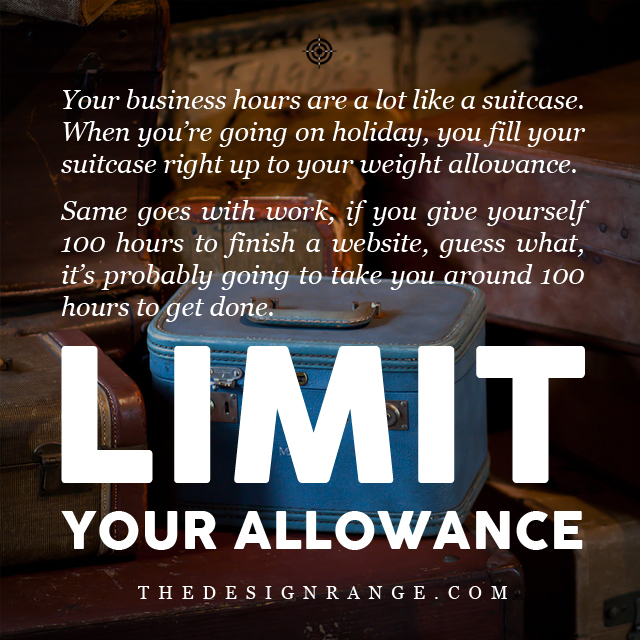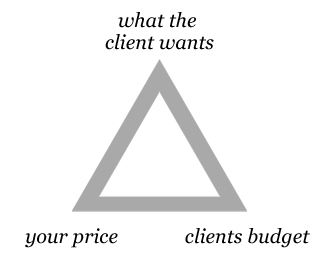5 Ways to Give Yourself a Pay Rise
1 CommentYou know what I miss about being an employee of a company? Ladders. You know what I’m talking about; the climb. The clear next step that you’d have to take to progress your career, to take another step up the ladder. From team member, to assistant manager, to manager, to area manager and so on… but with cooler titles obviously, because that companies job titles sound boring as shit, bad example. Obviously though with each of those steps up the ladder comes that boost to your pay packet, which is probably the main reason anyone would want a promotion.
Being a freelancer, you may not be able to go after that new title (well I mean you could I guess, but you’d be giving it to yourself so… it’d be a bit weird), but you sure as hell can give yourself a pay rise.
Now when you’re working for a company there are two ways to get a pay rise. One – you work really hard, to the point where your superiors feel stupid for not utilising your talents more effectively. Or two – you wait it out (we all know how when someone up the food chain gets a promotion, their shoes need to be filled, so the auto response is to go after the guy who’s ‘been here the longest’, you know, because they’ll have more experience).
Does your work ethic still suck? Oh it does? Then tough shit pal.
However in the world of the freelancer there is no option two. Have you been a freelancer for ten years? Oh you have? Do you feel like you deserve more money? Oh you do? Does your work ethic still suck? Oh it does? Then tough shit pal.
And that’s fair.
The only way you can increase your income as a freelance designer, photographer, developer or illustrator is if you deserve it.
Sweet little sound bite, but how do you actually action ‘deserving it’? Well here are five of very best ways you can bring in more cash at the end of the month.
1. Learn More
The most straight forward and obvious answer is to get better at what you do. There is always room for improvement, and that is a wonderful thing; could you imagine how dull this job would be if we couldn’t improve?
Take the next step in your career and learn a complimentary skill. Are you a frontend web developer? Start teaching yourself PHP so you can manage the backend too. Are you a vector illustrator? Have a play with digital paintings so you can offer a wider range of styles. The more you can do, the more you can charge. Having all those skills in just one head is a fantastic and highly desirable thing. Clients love having their design stuff under one roof (which is why agencies are so popular), so if you can do everything they need in one place and save them from darting about between designers and developers, then they’ll pay for the privilege.
2. Become a Specialist
The other direction you can go to get better is to really drill down into what it is that you do. Become a specialist in your industry, the name that’s on everyone’s lips when it comes to this one specific thing. Say for instance you’re an interior photographer, you could become the premier hotel room interior photographer. Or you’re a brand designer, you could be the only name in health food business branding.
If you market yourself as being literally exactly what they’re looking for, then the only reason that they won’t be hiring you is that they can’t afford you.
Granted, you are taking yourself off the market for a lot of clients, but by really concentrating on your niche in the market, you’re making the choice for the client obvious. If you market yourself as being literally exactly what they’re looking for, then the only reason that they won’t be hiring you is that they can’t afford you.
3. Use Stock
Say you’re happy with the service you’re offering for whatever reason (honestly though – I don’t think this should ever be the case), how else can you boost your income? Well you do more of what you do; you work faster.
When I say faster, I’m not talking about dipping your head in a vat of coffee, popping a pencil in each hand and going crazy like the Tasmanian Devil. What I really mean is smarter, but since I’m talking about fitting more work into the same time it makes sense.
Bill Beachy wrote a very useful article not long ago along these lines called How to Become a Faster Graphic Designer, so in addition to giving that a read, here are a few things that you can do to push out more work in the same amount of time.
Whatever it is you’re trying to do, chances are someone has already done a chunk of it
Use other people’s time to save your own. Whatever it is you’re trying to do, chances are someone has already done a chunk of it, and is willing to sell you that chunk for a very reasonable price. It’s a nice idea to look at a finished design safe in the knowledge that every last bit of it came from you, but in reality when you’re against the clock and trying to earn a living, it’s not always practical. When I’m having to work to a tight deadline I’ll often have a scan about on Graphic River or Photo Dune for the last bits and pieces I need to finish things off.
4. Template Your Work
Turn your own designs into templates. As you work your way through a design just a keep an eye out for when you do something especially good that you may be able to use again. As a web designer, this could be a little bit of code for a fancy image slider, or if you’re a graphic designer, perhaps you made a sticker graphic for a poster that you could use elsewhere. I’m constantly vetting my own designs for knick-knacks that I can use again in other projects.
5. Set deadlines AND set time limits
They sound similar, but they’re very different. A deadline is date by which a project must be finished and signed off by the client. A time limit, is the amount of time you’re allowed to spend on that project. You see, I used to set deadlines and think that was all I needed, but what ended up happening was that I’d find myself working into the night or over the weekends on a project. Yes I had defined a deadline, but every second up until that point was fair game.

(Pin it!)
Your business hours are a lot like a suitcase. When you’re going on holiday you fill your suitcase right up to your weight allowance. It doesn’t matter if you’re taking a wetsuit to the desert (and I have actually done just that) you fill it. Same goes with work, if you give yourself 100 hours to finish a website, guess what, it’s probably going to take you around 100 hours to get done. Limit your allowance. Don’t be stupid with it, but sit down and seriously think, if I had a gun to my head (Swordfish style) how quickly could I do this?

You need to make that your time limit for the project. We all work faster when we’re against the clock, but you need to be aware that this isn’t a race. Your limit for getting the job done should include getting it right and finishing it to a quality you’re happy with. It’s not about churning out rubbish at a rate of knots, that’s useless. It’s about producing the same kind of work you’re doing right now, but just having zero wasted time whilst doing it.
Photo Credit to Drew Coffman
